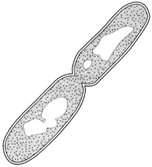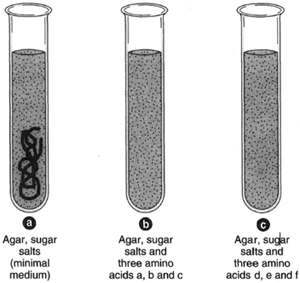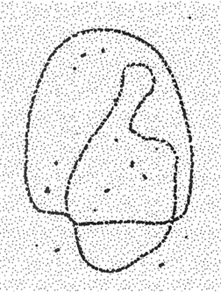Bacterial Growth
Bacteria divide by fission and may do so every twenty minutes in favorable living conditions. This suggests that in a given day, a given bacterium could come to weigh 2,000 tons. This, of course, does not happen.Because bacteria divide by fission, they are known as Schizophyta, or Schizomycetes (a term introduced by von Naegeli in 1857). The cytoplasmic membrane grows inwardly, the cell wall splits from the outside toward the center, and the cell divides into two daughter cells. Bacteria grow on organic matter by secreting enzymes outwardly into the surrounding medium, making possible the absorption of nutrients through the cell membrane. (Such enzymes are called exoenzymes.)
Some bacteria form (usually one but sometimes more) endospores. The protoplast rounds up in the cell by the loss of water and develops a heavy cell wall. In this way, the endospores can survive adverse conditions (even boiling water) for several hours. Endospores can be sealed in vacuum, reduced in temperature to −270°C (in liquid helium), and then restored to active growth again.
 |
| Figure 11-4 Bacteria divide by simple fission. |
Do bacteria have nuclei? Because the definition of a nucleus requires an enclosing membrane, the answer is no. But bacteria do have nuclear bodies sometimes two-because nuclear division generally precedes cell division. Each nuclear body consists of a circle of double-stranded DNA, a single chromonema (said to be 1,000 times longer than the cell in which it resides). Although reproduction occurs by transverse fission, a sexual process (a form of conjugation) has been observed.
Consider, now, some work done by Lederberg and Tatum involving a strain of Escherichia coli, the bacterium that grows in the colon. This bacterium is able to synthesize the amino acids it needs. This organism can thereby grow on a medium containing only glucose and some inorganic salts-a minimal medium (figure 11-5a). Lederberg and Tatum theorized that if such an E. coli were to lose the ability to make a needed amino acid because of a mutation (sudden; unexpected change in genetic material), it would no longer be able to thrive on a minimal medium; if, however, the amino acid that the mutated E. coli was unable to make were added to the medium, the bacterium would grow (figure 11-5b).
Lederberg and Tatum used ultraviolet radiation to induce mutations in E. coli and, thereby, succesfully developed two strains, each of which had lost the ability to manufacture three amino acids. The three amino acids that strain number II could not make were not the same three as those that strain number I could not make. Let us say that strain number I could not make amino acids a, b, and c. It could not, therefore, growo n the minimal medium.
 |
| Figure 11-5 Culture tube (a) contains only a minimal medium composed of agar plus some sugar and salts. Culture tube (b) contains the same ingredients plus three amino acids; a, b, and c. Culture tube (c) contains the same ingredients as does culture tube( a) plus the amino acids d, e, and f. |
It could, however, grow on the same type of medium if the amino acids that it was unable to make (that is, types a b, and c) were added to the medium (figure 11-5b). Similarly, strain number II could not make amino acids d, e, and f and could not grow on the minimal medium. It could, however, grow on a medium that provided amino acids d, e, and f (figure 11-5c). Although strain number I could not make amino acids a b, or c, it could make amino acids d, e, and f; likewise, although strain number II could not make amino acids d, e, or f it could make amino acids a b, and c. When Lederberg and Tatum mixed these two strains of bacteria and plated the mixture onto the minimal medium, a good growth of bacteria was observed (figure 11-5a). The electron microscope reveals a conjugation tube extending between two cells through which genetic material passes from one cell to the other. In this manner a cell having the full capacity to grow on a minimal medium is created. The DNA takes the form of a fine thread as it passes across the tube bridge. One bacterium is a donor cell and the other is a recipient. The DNA strand is at first in the form of a circle, the ends being united (figure 11-6). The circle breaks at a specific point, and the long strand then moves across the bridge. Varying portions of the molecule may be transferred in this process called parasexual.
 |
| Figure 11-6 The DNA filament in a bacterial cell takes the form of a complete circle. |




